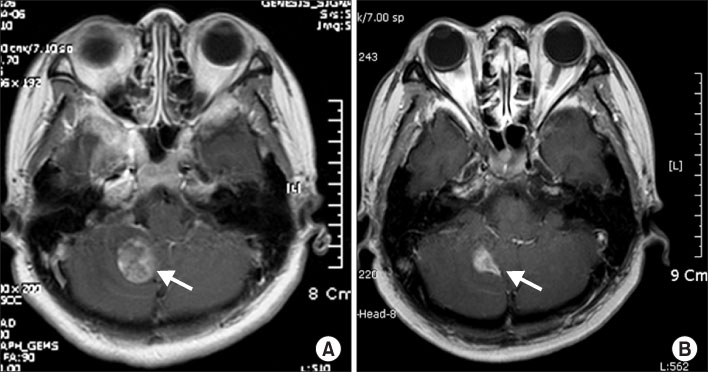Tuberc Respir Dis.
2010 Nov;69(5):381-384.
Cavernous Sinus Metastasis of Non-Small Cell Lung Cancer
- Affiliations
-
- 1Department of Internal Medicine, Korea Cancer Center Hospital, Seoul, Korea. jclee@kcch.re.kr
- 2Department of Opthalmology, Korea Cancer Center Hospital, Seoul, Korea.
Abstract
- Progressive ptosis and headache developed in a 50-year-old woman with non-small cell lung cancer. Although brain magnetic resonance imaging showed improved cerebellar metastasis after prior radiotherapy without any other abnormality, the follow-up examination taken 6 months later revealed metastasis to the cavernous sinus. The diagnosis of metastasis to the cavernous sinus is often difficult because it is a very rare manifestation of lung cancer, and symptoms can occur prior to developing a radiologically detectable lesion. Therefore, when a strong clinical suspicion of cavernous sinus metastasis exists, thorough neurologic examination and serial brain imaging should be followed up to avoid overlooking the lesion.
Keyword
MeSH Terms
Figure
Reference
-
1. Lee JH, Lee HK, Park JK, Choi CG, Suh DC. Cavernous sinus syndrome: clinical features and differential diagnosis with MR imaging. AJR Am J Roentgenol. 2003. 181:583–590.2. Bitoh S, Hasegawa H, Ohtsuki H, Obashi J, Kobayashi Y. Parasellar metastases: four autopsied cases. Surg Neurol. 1985. 23:41–48.3. Oneç B, Oksüzoğlu B, Hatipoğlu HG, Oneç K, Azak A, Zengin N. Cavernous sinus syndrome caused by metastatic colon carcinoma. Clin Colorectal Cancer. 2007. 6:593–596.4. Thomas JE, Yoss RE. The parasellar syndrome: problems in determining etiology. Mayo Clin Proc. 1970. 45:617–623.5. Spell DW, Gervais DS Jr, Ellis JK, Vial RH. Cavernous sinus syndrome due to metastatic renal cell carcinoma. South Med J. 1998. 91:576–579.6. Hui AC, Wong WS, Wong KS. Cavernous sinus syndrome secondary to tuberculous meningitis. Eur Neurol. 2002. 47:125–126.7. Lin CC, Tsai JJ. Relationship between the number of involved cranial nerves and the percentage of lesions located in the cavernous sinus. Eur Neurol. 2003. 49:98–102.8. Keane JR. Cavernous sinus syndrome. Analysis of 151 cases. Arch Neurol. 1996. 53:967–971.9. Finsterer J. Ptosis: causes, presentation, and management. Aesthetic Plast Surg. 2003. 27:193–204.10. Greenberg HS, Deck MD, Vikram B, Chu FC, Posner JB. Metastasis to the base of the skull: clinical findings in 43 patients. Neurology. 1981. 31:530–537.11. Vikram B, Chu FC. Radiation therapy for metastases to the base of the skull. Radiology. 1979. 130:465–468.12. Yap YC, Sharma V, Rees J, Kosmin A. Cavernous sinus syndrome secondary to metastasis from small cell lung carcinoma. Ann Ophthalmol (Skokie). 2007. 39:166–169.13. Laigle-Donadey F, Taillibert S, Martin-Duverneuil N, Hildebrand J, Delattre JY. Skull-base metastases. J Neurooncol. 2005. 75:63–69.14. Ebert S, Pilgram SM, Bähr M, Kermer P. Bilateral ophthalmoplegia due to symmetric cavernous sinus metastasis from gastric adenocarcinoma. J Neurol Sci. 2009. 279:106–108.15. Panigrahi M, Arun P. Rajasekhar V, Bhattacharyya KB, editors. Uncommon cavernous sinus lesions: a review. Progress in clinical neurosciences, vol. 22. 2007. Delhi: Byword Books;237–247.16. Post MJ, Mendez DR, Kline LB, Acker JD, Glaser JS. Metastatic disease to the cavernous sinus: clinical syndrome and CT diagnosis. J Comput Assist Tomogr. 1985. 9:115–120.
- Full Text Links
- Actions
-
Cited
- CITED
-
- Close
- Share
- Similar articles
-
- Two Cases of Cutaneous Metastasis from Small Cell Lung Cancer
- A Case of Pituitary Metastasis of Lung Cancer Presenting as Cavernous Sinus Syndrome
- Ovarian Metastasis from Non-Small Cell Lung Cancer Responding to Erlotinib
- Cutaneous Metastasis from Small Cell Lung Cancer Expressing Thyroid Transcription Factor-1
- A Case of Iris Metastasis from Non-small Cell Lung Cancer




